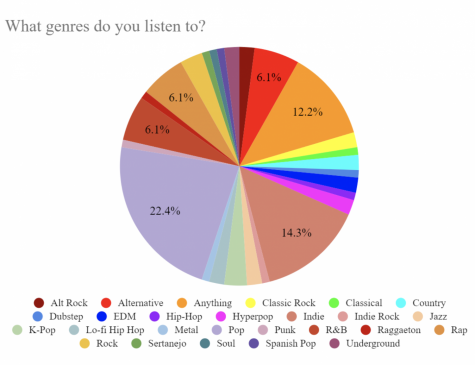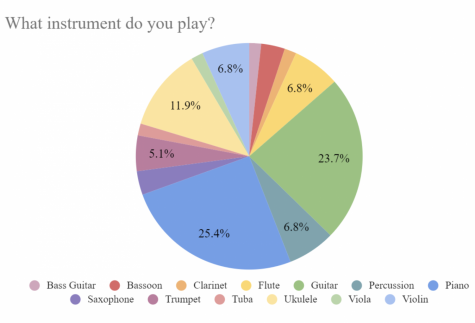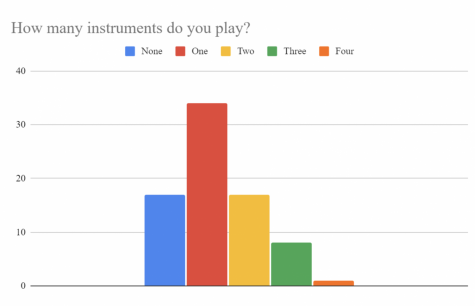This school’s summer sounds: surveyed
October 9, 2020
 Have you ever looked at the Billboard Hot 100 and thought, “how are there songs I’ve never heard of on here?” Because I have. In fact, I’ve always wondered what the people around me listen to, so I decided to ask around.
Have you ever looked at the Billboard Hot 100 and thought, “how are there songs I’ve never heard of on here?” Because I have. In fact, I’ve always wondered what the people around me listen to, so I decided to ask around.
When I asked Liberty students what they listen to¹, one thing stood out to me: most people listen to pop. Since I allowed people to get as specific or vague as they wanted, it might initially look as though less than a quarter of people listen to “popular” music. However, that isn’t true. 44% of people listed “pop” in their response to the question, and that increases to 64% when you include the people who listen to “anything.” After that, indie is the second most popular, with 28% of people including it in what they listen to.
 Of course, this isn’t all I asked. I wanted to see if knowing how to play an instrument had any bearing on what you listen to. There isn’t a significant difference—both musicians and non-musicians listen primarily to pop and indie, with rock, rap, and R&B sprinkled in alongside the less popular genres. The major difference overall is in specificity: musicians were most likely to reply with more specific examples of music they listen to, and those examples were more frequently “hyper-pop” or “K-pop” rather than just “pop.” The sole exception to this was the four flute players who responded to the survey. All of them replied with exclusively pop music. While I could chalk this up to being borne out of the low sample size, it also lines up well with a lot of the cool, trendy flautists I know. After all, listening to what’s popular isn’t a bad thing—most pop music is pop for a reason.
Of course, this isn’t all I asked. I wanted to see if knowing how to play an instrument had any bearing on what you listen to. There isn’t a significant difference—both musicians and non-musicians listen primarily to pop and indie, with rock, rap, and R&B sprinkled in alongside the less popular genres. The major difference overall is in specificity: musicians were most likely to reply with more specific examples of music they listen to, and those examples were more frequently “hyper-pop” or “K-pop” rather than just “pop.” The sole exception to this was the four flute players who responded to the survey. All of them replied with exclusively pop music. While I could chalk this up to being borne out of the low sample size, it also lines up well with a lot of the cool, trendy flautists I know. After all, listening to what’s popular isn’t a bad thing—most pop music is pop for a reason.
Something that surprised me in the responses regarding musicianship was that only one out of every three students surveyed don’t play an instrument. The most popular are piano and guitar, with 44% of musicians playing piano and 41% playing guitar. Outside of those, stringed instruments and wind instruments were approximately the same popularity, though the latter was clustered in a handful of multi-instrumentalists and the former’s count was bolstered by the high number of ukulele players.
that surprised me in the responses regarding musicianship was that only one out of every three students surveyed don’t play an instrument. The most popular are piano and guitar, with 44% of musicians playing piano and 41% playing guitar. Outside of those, stringed instruments and wind instruments were approximately the same popularity, though the latter was clustered in a handful of multi-instrumentalists and the former’s count was bolstered by the high number of ukulele players.
I mentioned earlier that most pop is pop for a reason, and the reason is that it’s a formula that works. Standard chord progressions in popular music are catchy and pleasing to the ear. I asked what people have been listening to recently and compiled the responses into a playlist². While a lot of it is more “indie” than “pop,” there is a structure and sound that makes everybody’s song suggestions more cohesive than one might expect. Even the artists people listen to align to the same overall sound—popular responses such as Lorde, Conan Gray, and Billie Eilish share themes both musically and lyrically.
Chances are, if you look at the Hot 100 and you don’t know the songs on there, you have at least heard that style. It might not always be what you’re “into,” but with what I’ve learned from this survey, if you’re into pop then there’s a good chance you will like the lesser-known artists on there far more than you’d first think.
1: Survey of 51 students, with a bias towards senior girls
2: The playlist can be found here: https://open.spotify.com/playlist/1NOxHwxzXv0xyIaUOdQkjJ (some songs contain explicit content)


